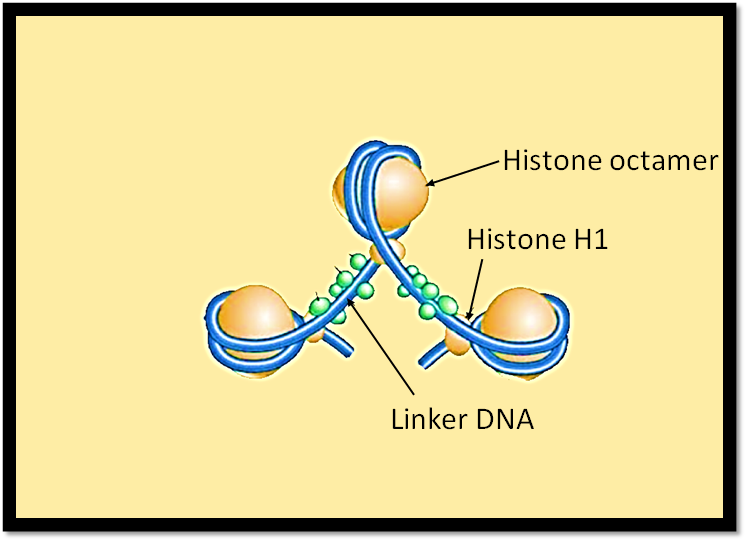
One solenoid is composed of
(a)8 nucleosomes
(b)6 nucleosomes
(c)10 nucleosomes
(d)16 nucleosomes
Answer
574.8k+ views
Hint: DNA is often packed and coiled at many different stages and at each stage it becomes more and more condensed and tightly packed. With each fold, the number of nucleotides goes on increasing.
Complete answer:
In the nucleus, DNA is wrapped around positively charged proteins called Histones. Two histone H2A-H2B dimers, two histone H3 proteins, and two histone H4 proteins together form an octamer of histones around which the DNA can be wrapped. The first stage of the packaging looks like a ‘beads on a string’ model and is of 11nm. Another type of histone protein called H1 binds to the sites where DNA enters and exits the nucleosome. Each octamer wrapped with DNA is called a nucleosome. In a solenoid structure, the nucleosomes are stacked and are connected by bent linker DNA. The nucleosomes are positioned with the histone H1 proteins facing toward the center and at this position, they form a polymer. A helix is formed containing 6 nucleosomes in each turn.
Additional Information: For the entire DNA to fit into a small cell, the DNA has to be folded and packed well. By doing so, three-meter of DNA is accommodated into a cell’s nucleus which is much smaller in size. The three orders of DNA packaging are –
-Nucleosome i.e. first order
-Solenoid fiber i.e. second order
-Scaffold loop i.e. third order.
So, the correct answer is ‘6 nucleosomes’.
Note: John Finch and Aaron Klug proposed the solenoid model of DNA in 1976. They used techniques of electron microscopy and X-ray diffraction to determine this structure. It was the first model proposed for the 30nm fiber structure.

Complete answer:
In the nucleus, DNA is wrapped around positively charged proteins called Histones. Two histone H2A-H2B dimers, two histone H3 proteins, and two histone H4 proteins together form an octamer of histones around which the DNA can be wrapped. The first stage of the packaging looks like a ‘beads on a string’ model and is of 11nm. Another type of histone protein called H1 binds to the sites where DNA enters and exits the nucleosome. Each octamer wrapped with DNA is called a nucleosome. In a solenoid structure, the nucleosomes are stacked and are connected by bent linker DNA. The nucleosomes are positioned with the histone H1 proteins facing toward the center and at this position, they form a polymer. A helix is formed containing 6 nucleosomes in each turn.
Additional Information: For the entire DNA to fit into a small cell, the DNA has to be folded and packed well. By doing so, three-meter of DNA is accommodated into a cell’s nucleus which is much smaller in size. The three orders of DNA packaging are –
-Nucleosome i.e. first order
-Solenoid fiber i.e. second order
-Scaffold loop i.e. third order.
So, the correct answer is ‘6 nucleosomes’.
Note: John Finch and Aaron Klug proposed the solenoid model of DNA in 1976. They used techniques of electron microscopy and X-ray diffraction to determine this structure. It was the first model proposed for the 30nm fiber structure.

Recently Updated Pages
Why are manures considered better than fertilizers class 11 biology CBSE

Find the coordinates of the midpoint of the line segment class 11 maths CBSE

Distinguish between static friction limiting friction class 11 physics CBSE

The Chairman of the constituent Assembly was A Jawaharlal class 11 social science CBSE

The first National Commission on Labour NCL submitted class 11 social science CBSE

Number of all subshell of n + l 7 is A 4 B 5 C 6 D class 11 chemistry CBSE

Trending doubts
Differentiate between an exothermic and an endothermic class 11 chemistry CBSE

10 examples of friction in our daily life

One Metric ton is equal to kg A 10000 B 1000 C 100 class 11 physics CBSE

Difference Between Prokaryotic Cells and Eukaryotic Cells

State the laws of reflection of light

Explain zero factorial class 11 maths CBSE




